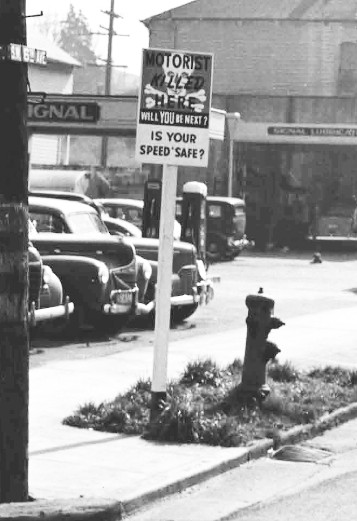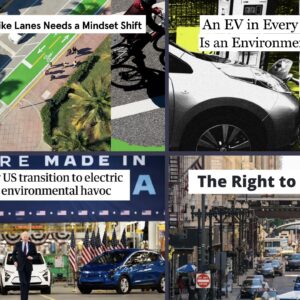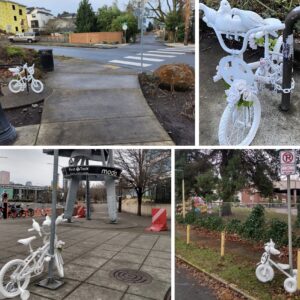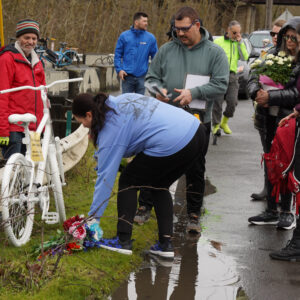A reader passed along an interesting photograph found on the Vintage Portland blog yesterday…

The photo was taken in 1944 and shows the corner of SW 6th and Columbia. The sign reads, “Motorist Killed Here. Will YOU be next? Is your speed safe?” and there’s a skull and crossbones looming in the background. I guess speed has been a problem on Portland’s streets for a long time.
Wonder if there’d be any chance of a sign program like this happening today? I wonder if it would help?
[Hat tip to Vintage Portland.]






Thanks for reading.
BikePortland has served this community with independent community journalism since 2005. We rely on subscriptions from readers like you to survive. Your financial support is vital in keeping this valuable resource alive and well.
Please subscribe today to strengthen and expand our work.
I wonder if they did do this, how many signs they’d have to put up…
In Montana we’ve had white crosses lining our highways for years at crash sites where people have been killed. It is always sobering when you come around a corner and see 4 white crosses on the side of the road.
A few years ago, after helping with some ghost bike projects, I started to realize that ghost bikes, like helmet hysteria and The Oregonian, fuel people’s conviction that bicycling is deadly dangerous.
Why doesn’t AAA park a white “ghost car” on every rural road twist or interstate highway bridge abutment that has claimed a motor vehicle occupant’s life?
Because it’s bad for business to admit that your product kills over 30,000 people in this country ever year.
I now look at ghost bikes as important temporary memorials but terrible long-term PR for bicycling. The way to really raise awareness about the true dangers on our roads should be to take a cue from Portland in 1944 (above). Forget “Eric’s Law,” HB 2030 which sought to memorialize dead bicyclists. Let’s see state-funded, state-made memorials to those who’ve died in the much more common way: in a car.
Motorists might care if they thought they were in danger. I’ve always kinda thought that the reaction motorists have when they see ghost bikes is “glad I’m safe in my car!” before any concern about cyclists. Yet they could stand to be reminded about how easy it is to die in that crumple-zone and airbag equipped luxury automobile of theirs.
Here’s an app idea:
At some point Google Maps, which is now providing directions for OnStar, will be able to provide routes that bypass slow traffic areas and construction.
What if they tied in to a database of all known traffic accidents and gave the user the option of routing around known danger zones? A possible side effect might be traffic load leveling off of large streets and on to slower and safer strees.
There appears to be a subtle but I think important difference between the message on the sign and the motivation behind the ghost bike tradition. If I’m interpreting the language on the sign correctly, “motorist killed here” it was the motorist’s own speed, or that of another motorist–if another was involved–that caused the death. In the cases of bicyclist deaths that I can think of it was a motorist that killed the bicyclist.*
The 1944 warning is to slow down because you might kill yourself. The ghost bike warnings to me say ‘watch the hell out for cars.’
*I realize that you find these labels often unhelpfully polarizing, Jonathan, and although I generally agree, the implications are different.
Q’Tzal @#5
A possible side effect of your app idea might be traffic load leveling off of large streets and on to slower and [formerly] safer streets.”
@q’Tzal #5: Ack! No! I don’t want more traffic on quiet side streets! Though I think the general concept of danger zones on Google driving maps is a great one.
I’ve proposed before and will propose again an alternate idea: now that Google has bike directions, one of the driving-direction options (along with “avoid highways” and “avoid tolls”) should be “avoid bikes”.
Eventually it could go a long way to creating separate bike infrastructure mostly by user choice.
not a good idea. We already have too much signage on the road (Billboards need to be outlawed, again).
Ghost Bikes are more directed at cyclists. They are an extension of a subculture. Which is fine.
However, I definitely agree we need more info about where and how drivers die so that others can make more informed route and driving decisions. I would love to know specifically where on HWY26 people have died so i can be more alert in those areas. A simple map, online, app, whatever, published by the state would help. I am sure they have the info. I am sure it will never happen.
When I see a ghost bike it is like a reminder for cyclists to be aware of their situation so they can keep themselves out of danger. IE: don’t pull up next to a truck or buss that is going to turn, dont ride full speed down a hill with no ability to stop or avoid a situation, keep your chin up and pay attn. to whats going on around you, don’t just stay in your own little bubble….
I wasn’t suggesting that traffic be routed to safers side streets but that it could be a side effect.
Routing though will take in to account the postd speed limits of all said side streets. Set bike friendly streets, heck ANY child fill residential area at 15 MPH.
Ultimately I think it would be useful to be see a HUD-like info sign warning drivers of areas more hazardous than others.
While cycling I keep thinking it’d be cool to have a warning highlighting drivers with bad records and assinine habits. Even in a car if I knew who were the bad drivers in advance i’d give them a wide berth.
Anne @ #8
“(along with “avoid highways” and “avoid tolls”) should be “avoid bikes”.”
!? Why would I want people driving cars to “avoid bikes”? If you mean don’t drive on them or through them I’m with you, but otherwise I don’t get it. I’d hope we could avoid stigmatizing bikes along with tolls and highways as tiresome manifestations of a crowded world.
“Eventually it could go a long way to creating separate bike infrastructure mostly by user choice.”
When we’re about half way there, the car infrastructure will be taken over by those modes that don’t require cheap fossil fuel. I’d rather focus on sharing the roads we have than build two sets of infrastructure unmindful of the fact that one of those will outlive the mode it now supports.
This might be a little bit of a stretch, but this post brings up an issue I’ve been thinking about since the recent repeal of the handgun restrictions by the Supreme Court.
I’m probably in the minority in Portland (and more so on BikePortland.org) in saying I’m a supporter of citizens being able to own a gun. Personally, I haven’t owned one in more than 10 years, but support those who legally can.
I say this because I wish the laws governing car ownership were as strict (or stricter) than those regarding gun ownership. The threats that drivers present to pedestrians, bicyclists, and other cars on a DAILY basis dwarfs the threats that gun ownership does in one’s everyday life. Just yesterday, I narrowly avoided getting hit by a crazy driver making a no-look left turn.
I see people propelling their 3,000lb+ machine at careless speeds through narrow streets, not looking both ways, talking on the phone, etc… When was the last time you saw a legal gun owner waving his gun around in public, talking on the phone while firing it willy nilly in the air?
I don’t want to get into a big discussion of the 2nd Amendment. And I know that there is a lot of carnage that guns cause. Just commenting on the apparent disconnect between these two sets of laws. A drivers license should be just as hard to get as a gun…maybe more so.
Thank you for allowing me to comment.
@ Sean #13: I think to get a gun you just fill out an info form. To get a license you have to take a written and a practical test. I get your comparison,though.
Machu,
Good point. I stand corrected. I’m tempted to believe though that violating any of the gun ownership rules even once could get your gun ownership priveleges revoked.
With cars, you can have multiple moving violations and still keep your car and licence.
I may be corrected yet again. (Thankfully, my ego isn’t threatened by the facts.)
It is odd that this sign looks to be facing away from drivers typical flow in traffic…unless it is a one way street or a two sided sign.